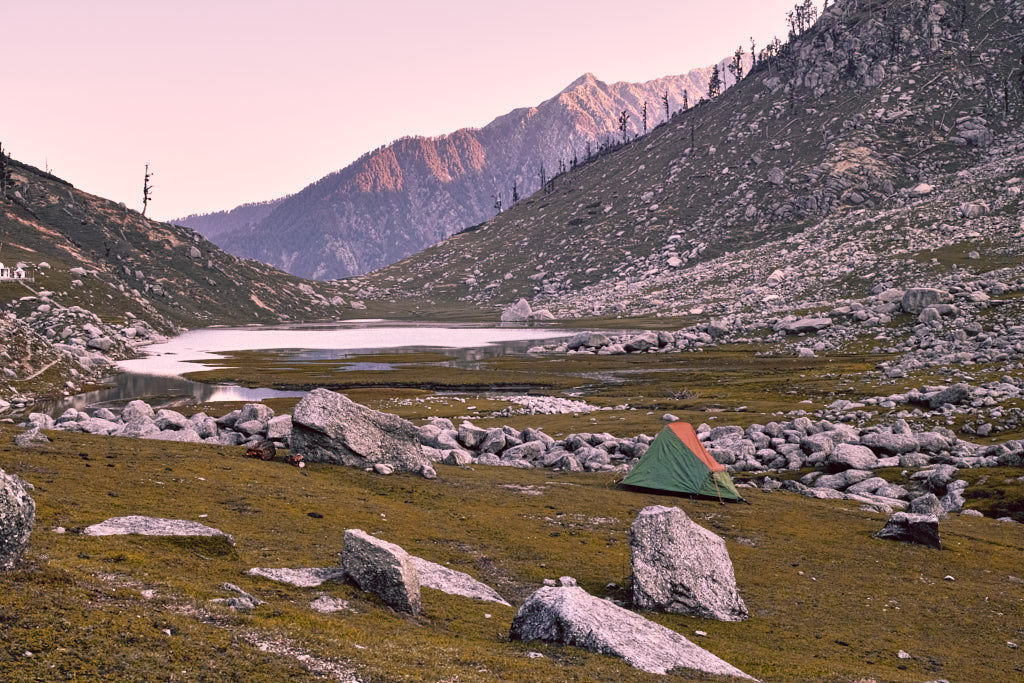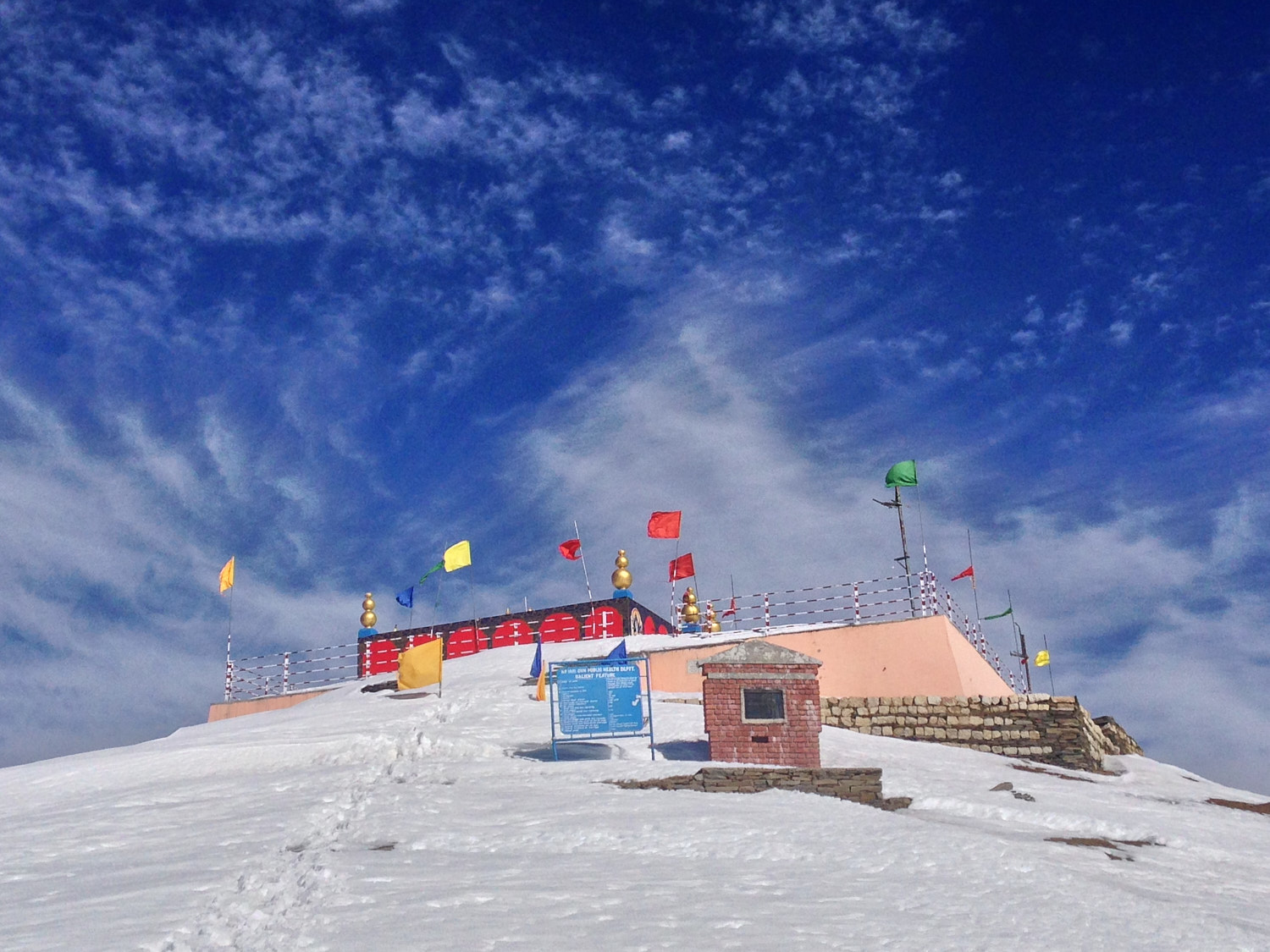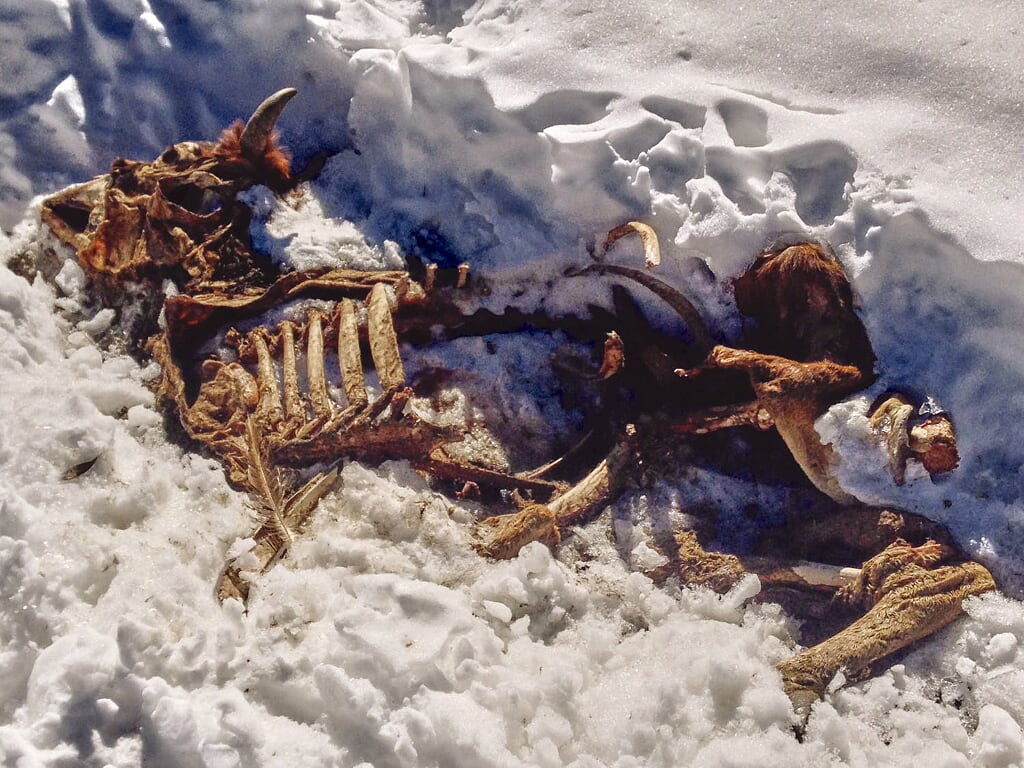Kareri Lake trek
Kareri lake is elusive. I tried to reach Kareri lake in January last year, but I was forced to turn back at the first water crossing. It wasn’t the cold, snow or the trail difficulty that fazed me. It was a leopard.

Yes, a spotted leopard crouched on a tree, hardly fifty metres from where I stood. I didn’t see the leopard first, it was some dead leaves falling from a tree that cautioned me. As I crept forward I saw ‘something’ crouched against a tree bole. At that moment, the leopard leapt from one tree to the other in slow sinuous grace. Spellbound, dumbstruck and scared, I turned around and beat a hasty retreat down the trail I had climbed. It was only after I reached the Kareri-Salli link road that I heaved a sigh of relief. In retrospective now, this was probably the fastest one kilometre I have ever covered on a trek.
Table Of contents
Trek Diary
The leopard haunting marked the end to my Kareri lake winter trek ambition in 2015. Yet throughout 2015 the inability to get to Kareri rankled in my head. In spring 2016, I decided to retry the Kareri lake trek. With more human thoroughfare in spring, I figured that the leopard would have relocated to a different watering hole.
Since the spectre of the leopard haunted me and I decided to start late in the day for my trek. At 1000 hours I was at the intersection which marks the start of the Kareri lake trail. Alas, the quirky wooden bridge over Nyund stream is no more. A victim of ‘development’, it’s been replaced by a larger motorable concrete bridge.

My senses were on high alert until I reached the watering hole. My eyes were scanning every turn in the trail for a potential ambush spot. It was only after crossing the watering hole that I could relax and enjoy the hike. The gurgling Nyund stream with its multitude of pools, waterfalls and eddies made a pleasant trekking companion.
Kareri lake has an eerie effect on anyone in love with the mountains. This placid glacier-fed lake that sits nestled under the towering Dhauladhars. Yet, with its placidity, it imparts vitality to a visitor that washes away ennui and tiredness. It urges you to get up and explore and yet, explore sans haste. You breathe deep, soak in the ambience, smell the rhododendrons, feel the unfettered mountain air in your hair till it becomes a part of you. With each passing day, it gets difficult to turn back to the city. If I had a month to spare, I’d camp next to Kareri and explore this nook of Dhauladhars.
Trek Detail
The Nyund nullah (stream) trail is a better name for the Kareri lake trail. Nyund stream emerges from Kareri lake and flows down to Nauhli village. The trekking trail follows this nullah upstream and crosses it at three places. Twice over a series of rocks and boulders and the once over a rickety iron bridge.
As I write this article, work is underway to complete the Salli-Kareri road link. This roadwork will connect the Nyund stream bridge near Nauhli village to Salli as well as Kareri. The Salli route is a far easier approach for anyone travelling from Pathankot and Shahpur via NH154. Just after Shahpur get off the National Highway and take the link road to Salli village. From the Salli water power project this soon to be completed metalled road links Nauhli and then Kareri village. Note: As of now (10/06/2016) you can motorcycle to Kareri from Salli. Four-wheelers have to stop half a kilometre before Kareri village (near Nauhli) as the last bridge on this road is incomplete.
The traditional start to the trail is the Forest Rest House (FRH) at Kareri village. Just aft of the rest house a trail joins the wide and now metalled Kareri-Salli link road. Follow the link road from Kareri towards Nauhli village for three kilometres. Just before Nauhli village, there is a large concrete bridge over Nyund stream. Adjacent to the bridge a stone-paved path leads upstream to your right. A tea shack has come up near this bridge (since 2016) and it marks the starting point for Kareri lake trek.

The stone-paved path winds upstream through a dense wood for the next 750 metres. The Nyund stream lies to your left. The trail emerges from the wood at the leopard watering hole (named in honour of my leopard encounter in 2015). This is the first crossing over Nyund stream that requires you to walk over a series of boulders. Just after the stream crossing, is a stiff 300-metre climb over a series of rock-cut steps. This is the steepest climb on this trail. The stone cut steps end on a small plateau. During the trekking season (May-October) one usually finds a shop here run by an enterprising person from Nauhli village. I came across a young schoolboy and his dog watching over the shop on behalf of his father. He was expecting a group of school children from Dharamshala and his earnestness convinced me to buy a few candies from his shop.
From this plateau, the trail ascends in a westerly direction through a broadleaf forest. 500 meters from the plateau you come across a section where the trail has eroded to a muddy mess. Be careful who traversing this muddy section. Barbed wire to your right, next to the trail guides you through the next 600 metres. The trail rejoins the Nyund stream near Jammu Goth. Just before Jammu Goth, another eroded muddy section needs to be traversed with a bit of care.
From Jammu Goth on The trail heads due North. You walk along the left bank of Nyund stream now. Many water pools and waterfalls dot this path and this is by far the most relaxed stroll on the trail. 500 meters from Jammu Goth there is a perfect wading hole to your right. Flecked with stones this waist-deep water hole is the perfect place to bathe and have a meal or a snack. 200 meters from this pool you cross the stream again, only this time on a rickety iron bridge.
After the iron bridge, the trail meanders north along Nyund nullah’s right bank. Huge boulders and massive trees dot the landscape and one needs to keep trudging north over a part mud, part stone-paved well-marked trail. The trail is clearly visible and 600 metres from the bridge is a shop on the left bank of Nyund stream. The shop approach is a cleverly constructed bridge with two tree trunks and some planks nailed over them. Just next to the shop on the right bank is an excellent camping ground.

From the shop, the trail meanders and ascends gradually along large boulders and even larger trees. The path is interspersed with packed mud trail. Numerous Gaddi shelters and lean-tos dot this part of the trail and along the way, you come across patches with heavy tree felling. I could not decipher whether this tree felling was natural or man-made. 3.2 kilometres from the shop is the final crossing over Nyund nullah, this time over a set of stones. 200 meters from this stream crossing lies the Shiv Shakti temple along the banks of Kareri lake.
Trek Summary
- Type - Overnight Trek. moderate (3-season) and difficult (winter snow).
- Difficulty - Swiss Alpine Club (SAC) Scale - T2.
- Trek Duration - 5-6 hours ascent from Kareri village and 3-4 hour descent from Kareri lake.
- Trek Distance - 9.8 kilometres one way.
- Maximum Altitude - 2955 metres.
- Average Grade - 12%.
- Start and Finish - Kareri village Forest Rest House.
- Getting to Kareri village - Kareri village has poor public transport connectivity. Ghera is the nearest village to Kareri with a regular bus service to Dharamshala. From Ghera, you can hire a jeep to Kareri village. A jeep charges Rs. 400-500 one way and Rs. 50 per passenger between Ghera and Kareri village. A bus leaves Ghera village for Dharamshala at 0930, 1230 hours with the last bus leaving at 1630 hours.
- Hotels and stay at Kareri - There is a Forest Rest House (FRH) at Kareri. It can be booked by calling the Divisional Forest Officer (DFO) in Dharamshala. Phone: 01892-224887 / 01892-224959 / 01892-223345. The FRH caretaker may give you a room if there are no bookings till 1700 hours. Phone +91-9736525486. Kareri lake has a temple with 6-7 rooms. The rooms have no doors. Each room can sleep 3-4 people comfortably or 10 people at a stretch. The rooms are free yet, a contribution to the temple fund is appreciated. A tent is not required if you intend to stay within the temple premises. However, I recommend carrying a shelter because the lake bank to the east and the west are prettier and quieter than the temple premises. A potable water mountain stream makes the east bank a much sought after camping ground.
- Weather - Extremely fickle due to its close proximity to the Dhauladhars. On sunny days, a cap is essential to avoid sunburn. Fleece comes in handy for early mornings and late summer evenings. Since Dhauladhars block the view to the north, rain clouds may emerge over Minkiani Pass without any warning. I recorded a minimum temperature of -1 degree on a clear night at the end of April.
- Mobile Connectivity - A mobile signal with 2G data connectivity at Kareri-Salli link road. The signal is spotty at the start of the trail and disappears altogether after Jammu Goth. There is no mobile signal at Kareri lake.
- Caution - The trail is well marked and stone-paved except at two places where it has eroded in muddy sections. The woods around Kareri are notorious for foxes, bears and leopards. Wild animals avoid the trail during trekking season i.e. May to October. However, in off-seasons keep a sharp lookout for bears and leopards. Avoid wearing earphones on the trail as they tend to reduce your spatial awareness.

Essential Gear
- Sleeping mat
- Sleeping bag rated at 5 degrees or less
- Fleece for early mornings and late evenings
- Rain jacket/Poncho
- Sunglasses and cap/hat for a summer day
- Trekking poles
GPS Map, Waypoints & Log
Related
- Kareri Lake trek route as an interactive map
- [Frequently asked questions (FAQs) about Kareri Lake Trek]({% post_url 2016-07-01-Kareri-Lake-Trek-Frequently-Asked-Questions %}).
- [Kareri Lake Trek Photo Gallery]({% post_url 2016-07-03-Kareri-Lake-Trek-Photo-Gallery %}).
- [Parashar Lake Trek]({% post_url 2015-03-03-Baagi-village-To-Prashar-Lake-Winter-Trek %}) near Mandi (Himachal Pradesh).




